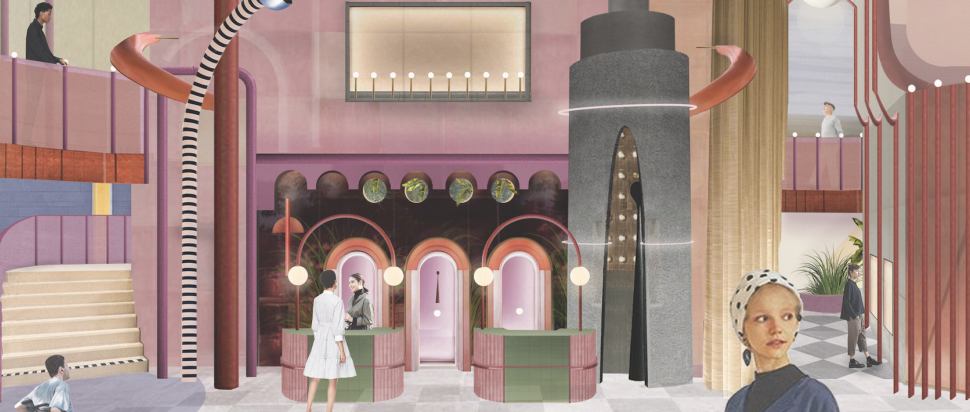GSA 2022: School of Design
This year’s Glasgow School of Art design graduates focus on tactility, sustainability, and relationships with the ecosystem
Optimistic and future-oriented, occasionally with a wry sense of humour, students from the GSA’s various design programmes present a critical appraisal of the value of materials and ideas. Many have made incredible use of the reopened studios and workshops, with work spanning a vast range of materials and processes.
Interior Design considers both relationships to, and the value of, spaces. Mollie Forsyth’s dreamy urban oasis Wonderlust proposes to convert abandoned Govan docks covered in layers of graffiti into an open space for the community to explore and shape. The docks are remnants of Glasgow’s industrial past, which Wonderlust would turn into public gardens, dance halls, community spaces and meditative installations. Forsyth imagines the space growing and transforming beyond its initial state, shaped by each visitor. Safe space and freedom of expression are particularly important for Aidan Rabbitt, whose Inside Out City is a forum to celebrate and unify the LGBTQIA+ Community in Glasgow and beyond. Based on lived experience of a lack of community spaces that aren’t nightclubs, Inside Out City is open to various age groups and needs. Housing libraries for children and adults, a queer archive, a space for making, café and exhibition spaces, it would become a haven on Buchanan Street.
The urban Glasgow environment is also a visually rich source for Textile Design graduates, with Arouge Salim’s embroidery taking night-time lighting as its inspiration by depicting the gradient and colour of lights and lasers in textiles. Circular frames create a spotlight while the threads form beams and bars of light, capturing the effects of lighting in nightclubs and retro arcades. Abbey Campbell’s Illusions of Colour are striking woven textiles exploring the interaction of colour, and how contrasting and complementary hues alter the tone of the original. Patterns in the work take inspiration from elements found in street scenes, including graffiti and crates.
The idea of incorporating discarded items is taken to the next level in Sophie Allardyce’s work. Her textiles are entirely made from found textile waste, including leather off-cuts salvaged from an interior seating manufacturer, discarded laser-cut MDF pieces, and beads and threads found in the GSA studios. These materials are bound and manipulated to create new forms, with sustainability at the core of the work. From reusing textile waste, to reconnecting with nature, Rosie Ridley’s work encourages the wearer to embrace the outdoors with coats filled with reclaimed yarn. Her collection is inspired by the Japanese concept of shinrin yoku, or forest bathing – a mindful approach to taking in, and being in, the atmosphere of green spaces. Her designs capture the delicacy of nature, allowing one to envision oneself within the natural world as opposed to shielding oneself from it.
Silversmithing and Jewellery graduates explore links between nature and recycling waste. Amy Findlay’s collection takes inspiration from slugs, overlooked creatures that play a vital role in the nutrient cycle, recreated in silver and bronze with inset stones. Her collection is a set of precious and tactile slugs that crawl up and wrap themselves around the body, their various forms reflecting stages in the life cycle. Further exploring the dichotomy of filthy and precious, Kristina Merchant’s collection is inspired by discarded items found littering the streets. Chewing gum carved from bone is incorporated in several pieces, while amber is used to create cigarette filters, alluding to traditional amber smoking pipes. Silver is thinly rolled, oxidised and manipulated to emulate burnt or crinkled paper, with ground waste amber used as tobacco filling.
Taking an unorthodox approach to silversmithing, Caitlin Murphy’s XYZ is inspired by geometric patterns and mathematical precision, using oxidised copper and bronze to weave optical illusions at a large scale. She is able to capture the malleability of metal through the influence of origami in various pieces in her collection.

A variety of prototypes exploring healthcare, play and sound can be seen from Product Design Engineering graduates this year. Optimisation in healthcare is the focus of Lois Jones’ Pill In (pictured above), which stores, organises, distributes, and dispenses large quantities of pharmaceuticals in an easy and efficient manner. Charlie Cumming’s tubular speaker is an out-of-the-box design that allows for customisation to individual genres of music by adjusting materials. The process of learning through play is explored in a toy designed by Morgan Rodgers, which aims to aid understanding in children undergoing radiotherapy. The toy captures the real-life movements, lights and sounds of a linac machine, and allows children to treat a teddy with support from a play therapist.
The relationship between humans, nature and technology is central to this year’s Interaction Design cohort. Dayna Lamb’s work explores the intersection of these three worlds in a multi-layered installation. Firstly, a trained algorithm predicts audience members’ personalities from a quiz, then media is chosen for them as they are led through a narrative of nature and synthesis. Lamb’s work spans a variety of outputs, from thermochromic prints to projections and a book. Lene de Montaigu’s piece addresses our relationships with the tangible world, focusing on memories objects hold. Her work is a response to the assumed cleanliness of interactive art, presenting a discarded-and-found piano – crumbling away, repaired using 3D printed parts, which the viewer can play. The suggested interaction is imperfect, human, and carries a living history. It wants to remember the forgotten, repair instead of replacing and thoroughly engage with the complexities of the everyday.
Communication Design graduates tell complex stories in engaging and imaginative ways. Some focused on how our emotional lives are shaped by our experience online. Agnes Boman’s frame-by-frame animation Cookies illustrates the transition from real to virtual spaces and anxieties that follow. Her animation loops, leading the viewer to look through the work twice, mimicking our distracted time online. Digital experiences are like empty calories – we have been entertained, but do not feel fulfilled. The exhausting overload of information we experience online is also explored by Emma Ralph in her work on the daily news. Using code, she scrapes repeating keywords in articles from news sites, arranging them alphabetically and seeking patterns. Emma’s work focuses on the design of a process, rather than an outcome, having her work change constantly and reflect on the multiplicity of representations.
Representation alters the lives and fates of communities. Katherine Wallace addresses its importance in her reimagining of Miracle in the Gorbals, a seminal ballet from 1944. Historically the Gorbals community has experienced neglect and negative portrayal, which the ballet itself echoed with distanced pity. Katherine’s version rethinks this paradigm, reshaping an archival work of art as a symbol of a new, self-made chapter for the area. Further exploring the human condition, Shannon Best focuses on cycles of life and death. Grass above the dead takes inspiration from the life and poetry of Elisabeth Siddal – the model for Ophelia in Millai’s famous painting. Best’s photographs depict a body drowning in nature, reclaimed, and absorbed. The message is nevertheless hopeful – death is the basis of new life, and seeds sprout from the remains.
Design graduates this year have addressed our relationship to space, nature, and heritage through a series of challenging, but forward-looking works. They closely examine the cycles of daily practices, social structures and suggest imaginative ways to reshape them.
The School of Design Degree Show runs 1-12 Jun in the Reid Building, 164 Renfrew Street, Glasgow. It is also available to view online at gsashowcase.net
